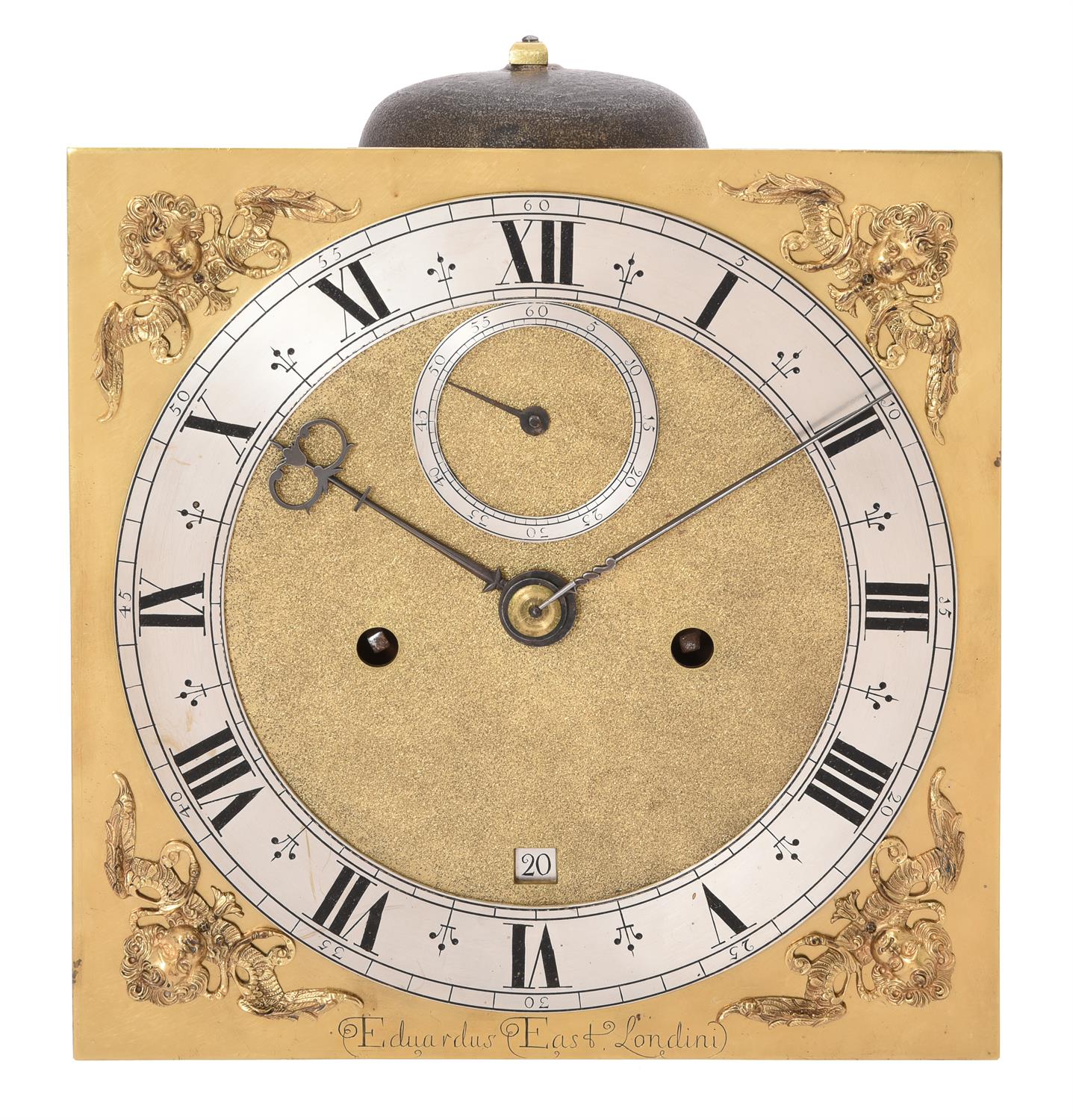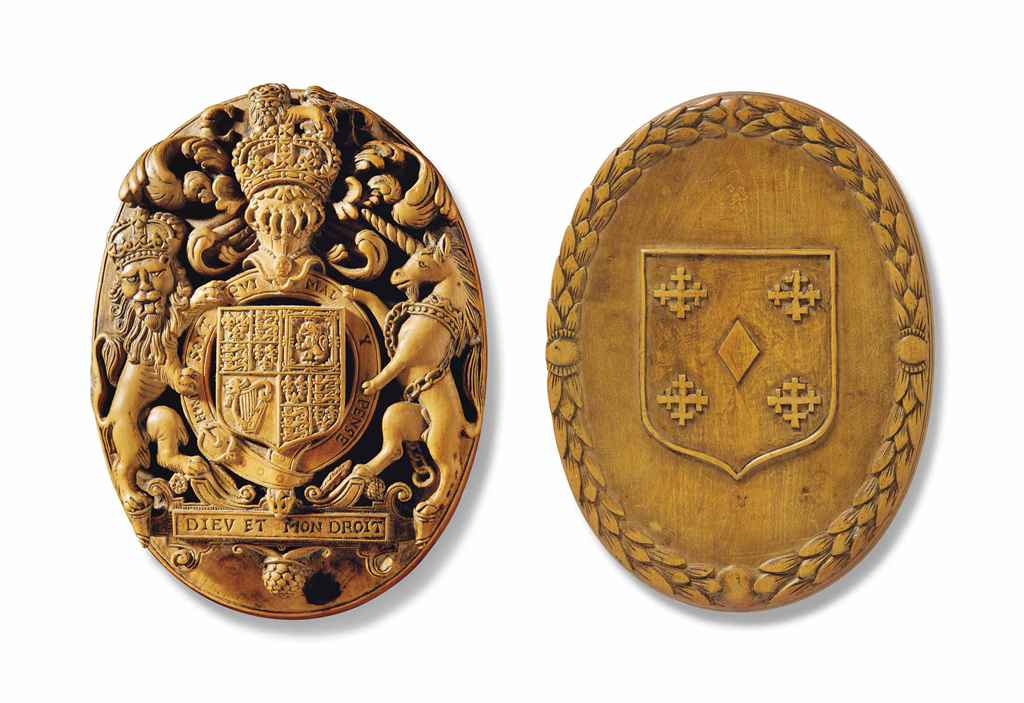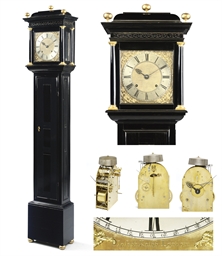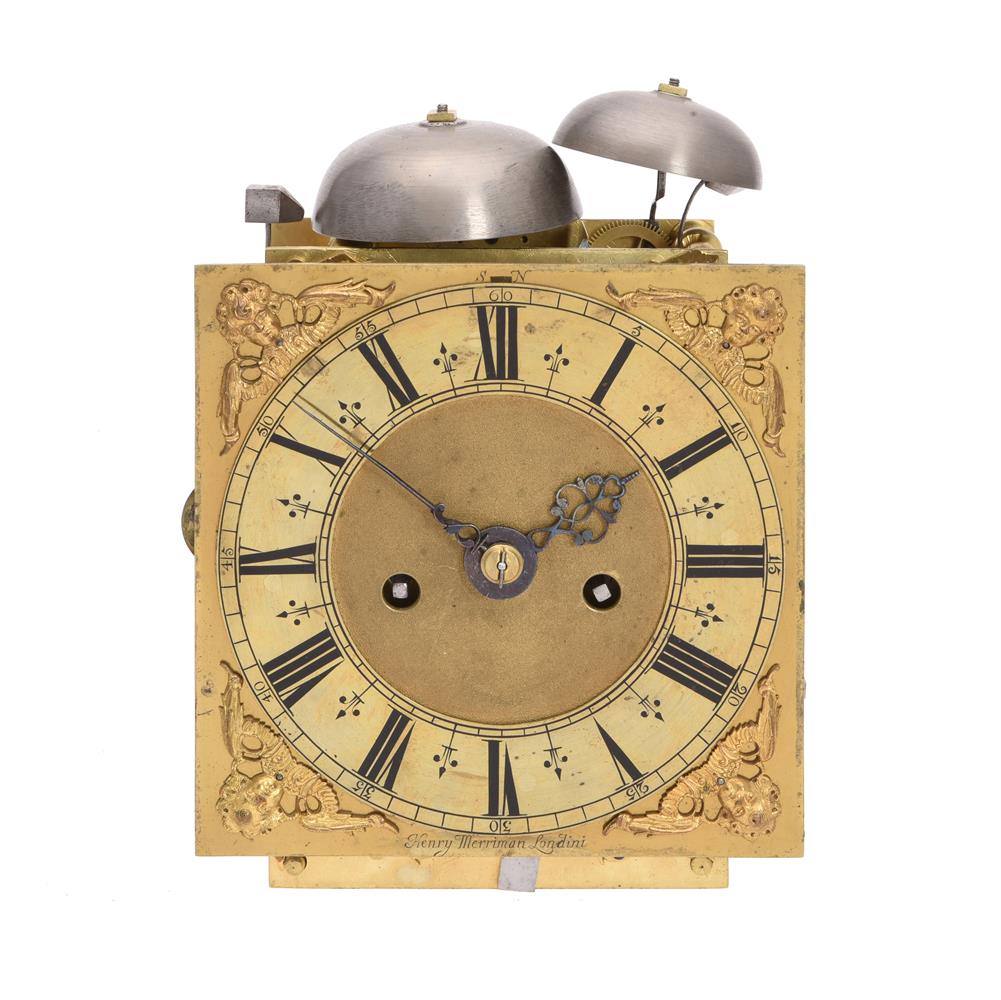A fine Charles II ebonised eight-day longcase clock Lawrence Debnam, Frome, dated 1675 The two-handed posted countwheel bell striking movement with column-turned corner uprights and resting on integral spikes fitted to the underside of the baseplate, the trains both with offset greatwheels each pivoted between a post attached to the baseplate opposing lug fitted to the one of the frame uprights, the going with anchor escapement incorporating solid 'battery brass' escape wheel and regulated by seconds pendulum, the strike sounding on a bell mounted above, the 10 inch square brass dial with iron hands and fine symmetrical scrolling tulip engraved centre issuing from a stylised urn to lower centre and incorporating flamboyant signature Lawrence Debnam, in Froome Fecit to upper margin, within applied Roman numeral chapter ring with stylised fleur-de-lys half hour markers and Arabic five minutes within the outer minute track, the dial plate engraved with the names Jam: Delanc and John Sentance along with the date 1675 beneath the chapter ring at two o'clock, the angles applied with winged cherub mask cast and pierced spandrels, the ebonised pine case with triangular pediment and architectural frieze over fixed glazed dial aperture and conforming rectangular side windows to the formerly rising hood, the trunk with convex throat moulding and 43 inch rectangular door, the plinth base with ogee mouldings to upper edges and on moulded skirt, 221cm (87ins) high. Literature: The current lot is documented in Darken, Jeff (editor) TIME & PLACE, English Country Clocks 1600-1840 as exhibit 5 pages 30-33 (where the movement and dial is extensively illustrated). Lawrence Debnam is recorded in Loomes, Brian Clockmakers of Britain 1286-1700 as born in Frome, Somerset in 1643 and was working from Cheap Street in the town from at least 1667 and is thought to have died in 1682/3. The presence of James Delance's signature beneath the chapter ring suggests that he was also involved in the making of the current lot. James Delance is recorded by Loomes as born in Downton, Wiltshire in 1655, he is believed to have learnt the clockmaking trade from Lawrence Debnam prior to moving to London in 1677 where he was admitted as a Free Brother to the Clockmakers' Company the following year. Delance remained in London until 1685 when he left the city and returned to Frome where he set up business in Cheap Street - probably succeeding Debnam who died in 1683 at the age of 40. By 1721 Delance had moved to Downton, Wiltshire and was still working in 1736. John Sentance appears to be unrecorded as a clockmaker although it could be considered possible that he was responsible for the remarkable engraved decoration to the centre of the dial. The current lot employs and escape wheel made from work-hardened 'battery brass' formed by hammering a cast solid disc prior to cutting of the teeth. This creates a wheel much more resilient to wear however this process makes it difficult to cross it out hence why it is left as a solid disc when fitted. It is perhaps appropriate to speculate that the current lot is probably one of the earliest West Country clocks to be fitted with anchor escapement with seconds pendulum; as such the maker(s) may have sought to experiment with the metallurgy of the escape wheel in order to ensure longevity of this new technology. This very rare feature appears to have been subsequently used by James Delance (see following lot) and it is testament to both makers that these wheels are still serviceable after over three hundred years of use. The layout of the trains suggests that when originally conceived the current lot was intended to have a duration of thirty-hours, however the maker chose to complete the clock with eight-day continuance and facilitated this by incorporating offset greatwheels each pivoted between a post attached to the baseplate opposing lug fitted to the one of the frame uprights. The frame uses typical 'Bristol' one-piece lantern
A fine Charles II ebonised eight-day longcase clock Lawrence Debnam, Frome, dated 1675 The two-handed posted countwheel bell striking movement with column-turned corner uprights and resting on integral spikes fitted to the underside of the baseplate, the trains both with offset greatwheels each pivoted between a post attached to the baseplate opposing lug fitted to the one of the frame uprights, the going with anchor escapement incorporating solid 'battery brass' escape wheel and regulated by seconds pendulum, the strike sounding on a bell mounted above, the 10 inch square brass dial with iron hands and fine symmetrical scrolling tulip engraved centre issuing from a stylised urn to lower centre and incorporating flamboyant signature Lawrence Debnam, in Froome Fecit to upper margin, within applied Roman numeral chapter ring with stylised fleur-de-lys half hour markers and Arabic five minutes within the outer minute track, the dial plate engraved with the names Jam: Delanc and John Sentance along with the date 1675 beneath the chapter ring at two o'clock, the angles applied with winged cherub mask cast and pierced spandrels, the ebonised pine case with triangular pediment and architectural frieze over fixed glazed dial aperture and conforming rectangular side windows to the formerly rising hood, the trunk with convex throat moulding and 43 inch rectangular door, the plinth base with ogee mouldings to upper edges and on moulded skirt, 221cm (87ins) high. Literature: The current lot is documented in Darken, Jeff (editor) TIME & PLACE, English Country Clocks 1600-1840 as exhibit 5 pages 30-33 (where the movement and dial is extensively illustrated). Lawrence Debnam is recorded in Loomes, Brian Clockmakers of Britain 1286-1700 as born in Frome, Somerset in 1643 and was working from Cheap Street in the town from at least 1667 and is thought to have died in 1682/3. The presence of James Delance's signature beneath the chapter ring suggests that he was also involved in the making of the current lot. James Delance is recorded by Loomes as born in Downton, Wiltshire in 1655, he is believed to have learnt the clockmaking trade from Lawrence Debnam prior to moving to London in 1677 where he was admitted as a Free Brother to the Clockmakers' Company the following year. Delance remained in London until 1685 when he left the city and returned to Frome where he set up business in Cheap Street - probably succeeding Debnam who died in 1683 at the age of 40. By 1721 Delance had moved to Downton, Wiltshire and was still working in 1736. John Sentance appears to be unrecorded as a clockmaker although it could be considered possible that he was responsible for the remarkable engraved decoration to the centre of the dial. The current lot employs and escape wheel made from work-hardened 'battery brass' formed by hammering a cast solid disc prior to cutting of the teeth. This creates a wheel much more resilient to wear however this process makes it difficult to cross it out hence why it is left as a solid disc when fitted. It is perhaps appropriate to speculate that the current lot is probably one of the earliest West Country clocks to be fitted with anchor escapement with seconds pendulum; as such the maker(s) may have sought to experiment with the metallurgy of the escape wheel in order to ensure longevity of this new technology. This very rare feature appears to have been subsequently used by James Delance (see following lot) and it is testament to both makers that these wheels are still serviceable after over three hundred years of use. The layout of the trains suggests that when originally conceived the current lot was intended to have a duration of thirty-hours, however the maker chose to complete the clock with eight-day continuance and facilitated this by incorporating offset greatwheels each pivoted between a post attached to the baseplate opposing lug fitted to the one of the frame uprights. The frame uses typical 'Bristol' one-piece lantern















Testen Sie LotSearch und seine Premium-Features 7 Tage - ohne Kosten!
Lassen Sie sich automatisch über neue Objekte in kommenden Auktionen benachrichtigen.
Suchauftrag anlegen